25 Top Generative AI Statistics For 2024

The artificial intelligence (AI) hype is here, spearheaded by an AI technology called generative artificial intelligence.
Generative AI is machine learning technology that uses natural language processing algorithms and generative adversarial networks to produce text, images, code, art and even music.
A few popular examples of this type of technology include ChatGPT, DALL-E and Jasper.ai.
In this post, we’ve listed the top generative AI statistics from reports published around the web.
Editor’s top picks – generative AI statistics
Here are the top five generative AI statistics from this article:
- By 2028, generative AI will reach a global market size of $51.8 billion. (Markets and Markets)
- Big tech and venture capital firms will invest $10.68 billion in generative AI in 2023. (Pitchfork)
- Of marketers who use generative AI to produce content, 55% use ChatGPT. (Botco)
- 95% of developers admit to using AI to produce new code for software applications. (Sourcegraph)
- Training teams on how to use generative AI effectively is a major roadblock affecting 50% of marketers’ adoption of AI. (Botco)
General generative AI statistics
1. The global generative AI market size will reach $51.8 billion by 2028
According to research conducted by Markets and Markets, the global market size for generative AI is $11.3 billion in 2023 and will reach $51.8 billion by 2028.
This increase is at a compound annual growth rate (CAGR) of 35.6% year over year.

The research covered more than 35 companies who are either AI based or have invested in the technology in some form of another.
Six regions were covered in the report, but the majority of companies analyzed are based in the United States.
This tells us that not only will AI companies and venture capital firms maintain AI spending, they’re also going to increase it.
Source: Markets and Markets
2. Funding for generative AI software will soon jump to $10.68 billion
According to data collected by Pitchfork, funding from venture capital firms and big tech to software companies who develop generative AI tools will reach $10.68 billion soon.

This comes from an announcement from Microsoft in which they revealed their intention to invest $10 billion into OpenAI, the company behind ChatGPT.
This is a jump from Quarter 1 of 2023’s average funding round of $1.69 billion per company.
Source: Pitchfork
3. 55% of marketers who use generative AI to produce content use ChatGPT
The generative AI market is a fast-growing industry with numerous tools to choose from. ChatGPT is the most popular among marketers.
When Botco surveyed 1,000 marketing professionals, they discovered that 73% use generative AI to produce content.
Of that 73%, 55% use ChatGPT.
Here are the other generative AI tools marketers are using:
- Copy.ai – 42% use this generative AI tool.
- Jasper.ai – 36%.
- Peppertype.ai – 29%.
- Lensa – 28%.
- DALL-E – 25%.
- MidJourney – 24%.
The top three are all AI writing tools.
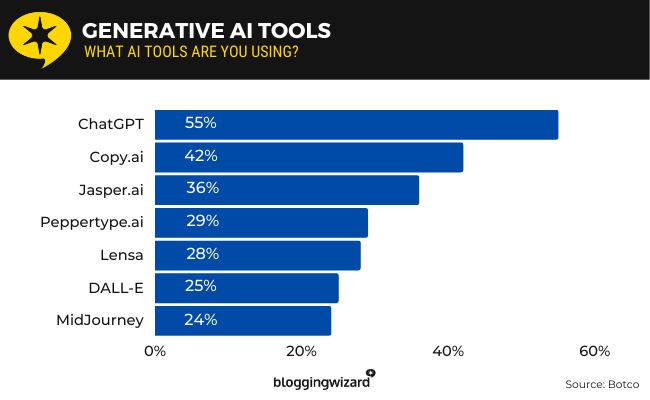
Keep in mind that Botco is a generative AI-based chatbot. This means their audience has a built-in bias toward adopting generative AI, so the numbers in their survey may be skewed when compared to the wider global market.
Source: Botco
4. Interest in generative AI is at its highest worldwide in June of 2023
According to data collected by Google in Google Trends, interest in the search term “generative AI” is at its highest in June of 2023 around the world.

Interest picked up in October of 2022 and skyrocketed after the release of ChatGPT on November 30, 2022.
Interest is highest in Singapore at 100, then China at 97, Hong Kong at 62, Israel at 55 and South Korea at 41.
The United States is in the 6th position on this list with an interest of 35.
Interest in this topic peaked in early June in the United States but is now starting to decline at a slow rate.
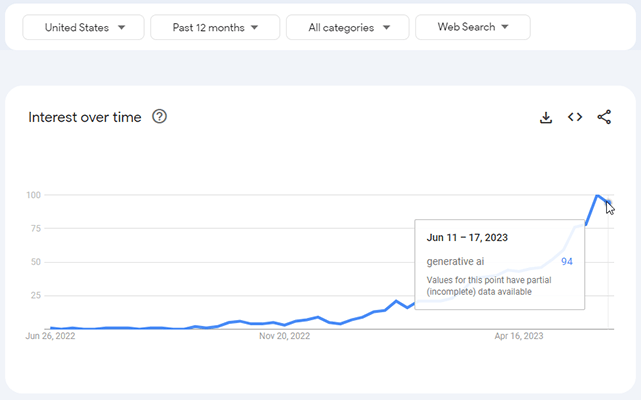
Source: Google Trends1, Google Trends2
5. Yale undergraduates correctly identified AI-generated art only 54% of the time
504 Yale undergraduates completed a survey in which they were asked to identify nine examples of art as being produced by a human or AI.
The undergraduates were only able to correctly identify AI-generated art 54% of the time.

This translates to five correct guesses out of nine.
Source: Yale Daily News
6. Only 38% of consumers think AI art is ethical
Big Village asked different generations about their sentiments on the ethics of AI-generated art.
They discovered that on average, only 38% of consumers think AI art is ethical.
Millennials are the most likely generation to adopt AI art as 48% of millennials think AI art is ethical.
This is followed by 39% of Gen Z, 37% of Gen X and 28% of baby boomers.
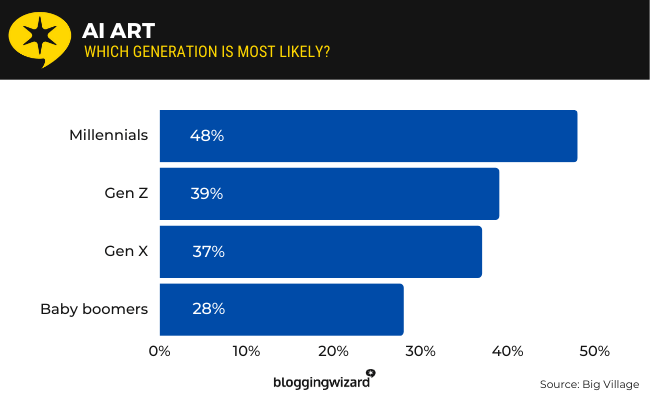
58.25% of consumers are worried about privacy in regards to AI-generated art.
56.25% think AI art will still be relevant in late 2023.
Source: Big Village
Generative AI adoption statistics
7. Images created by generative AI tools have the highest adoption rate at 69%
Botco’s data on adoption rates of generative AI techniques reveal that 69% of marketers have adopted generative AI for image creation.
Adoption rates for other generative AI techniques are as follows:
- Text Creation – 58% of marketers have adopted generative AI tools for text creation.
- Audio/Voice – 50%.
- Chatbots – 37%.
- Coding – 36%.

Source: Botco
8. 64% of executives feel a sense of urgency to adopt generative AI
Google surveyed 50 business and technology leaders.
They discovered although 64% feel a sense of urgency to adopt generative AI, only 4% feel their organizations have the necessary skills to do so.
In fact, 62% think their organizations “lack the most critical skills to execute their AI strategy.”
Source: Google
9. 66% of marketers whose organizations adopt AI see a positive return on investment
Botco’s survey revealed that 66% of marketers who adopted AI saw a positive return on investment (ROI) afterward.
43% saw two times the amount of ROI while 22% saw three times the amount.
Only 7% of marketers saw a negative ROI.
Source: Botco
10. 58% of marketers who adopt AI see an increase in performance
When Botco surveyed 1,000 marketers about their use of generative AI, they asked marketers about the benefits they experienced after adopting generative AI technology.
The biggest benefit was an increase in performance. 58% of marketers said their organization experienced this benefit after adopting AI.
50% saw an increase in the variety of content they produce, 50% saw cost efficiencies and 47% saw faster creative cycles.
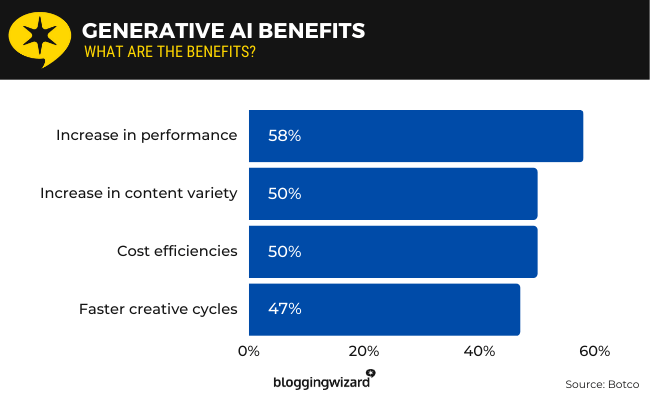
Source: Botco
ChatGPT statistics
11. Interest in ChatGPT is at its highest in mid 2023
According to data on search term popularity collected by Google in Google Trends, interest for ChatGPT is at its highest worldwide in mid 2023.
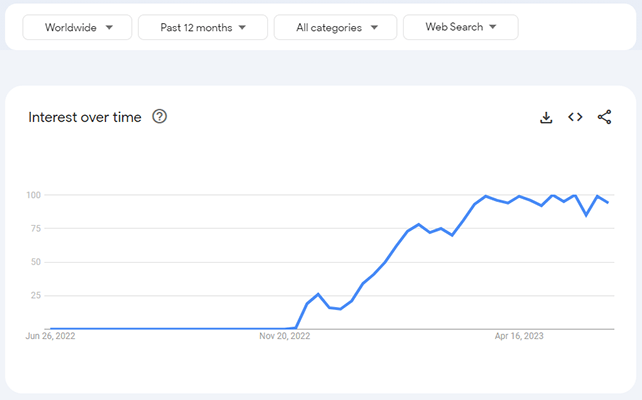
Interest originally picked up after the launch of ChatGPT on November 30, 2022 and skyrocketed in February of 2023.
Interest is highest in China at 100, then Singapore at 26, Nepal at 26, the Philippines at 21 and Pakistan at 20.
The United States, whose interest is at 8, is in the 52nd position on the worldwide list of regions most interested in ChatGPT.
If we switch the data over to the United States, we can see that interest in ChatGPT is at a rapid decline, though because interest in generative AI is still high in the United States, this decline could be due to the launch of competing generative AI tools.

Source: Google Trends3, Google Trends4
12. 43% of industry professionals have used ChatGPT in the workplace
Fishbowl, the creators of a social media app for industry professionals, surveyed 11,793 industry professionals about their use of ChatGPT.
They discovered that 43% of industry professionals have used ChatGPT in the workplace versus 57% who haven’t.
Source: Fishbowl1
13. 27% of industry professionals used ChatGPT for work within the first month of its release
ChatGPT, created by OpenAI, was made available to the public on November 30, 2022.
Fishbowl surveyed 4,500 industry professionals between January 4 and January 8 of 2023, about a month after ChatGPT was released.
When asked about whether or not they’ve tried ChatGPT for work-related tasks, 27% of respondents said they have.
Respondents included professionals from businesses like Amazon, JP Morgan, Meta, Nike, Bank of America, Google, IBM, Twitter and more.
Source: Fishbowl2
14. 29% of Gen Z professionals have tried ChatGPT at work
Fishbowl was able to break their data down from the previous question by generation.
They discovered that Gen Z had the highest adoption rate of ChatGPT in the workplace. They had an adoption rate of 29%.
However, millennials and Gen X followed close by with adoption rates of 27% and 28% respectively.
Source: Fishbowl2
15. 30% of men have tried ChatGPT in the workplace
Fishbowl was also able to break their data down by gender. This data revealed men as being more likely to adopt generative AI in the workplace.
They found that 30% of male respondents have tried ChatGPT at work versus 20% of women.
Source: Fishbowl2
16. ChatGPT is mostly adopted by marketing and advertising professionals at a rate of 37%
Fishbowl’s final breakdown for this question revealed that ChatGPT adoption was mostly seen in the marketing and advertising industry.
37% of professionals in that industry tried ChatGPT at work during the first month of its release.
These were the adoption rates for other industries:
- Tech – 35% of professionals in the tech industry used ChatGPT for work-related tasks during the first month of its release.
- Consulting – 30%.
- Teaching – 19%.
- Accounting – 16%.
- Healthcare – 15%.

Source: Fishbowl2
17. 68% of professionals who use ChatGPT at work are doing so without their bosses knowing
Fishbowl asked professionals whether or not their bosses know of their use of ChatGPT and other AI tools at work.
29% of professionals said their bosses don’t know about their use of ChatGPT in the workplace while 14% said their bosses do know.
Respondents were also able to choose “I do not use ChatGPT” as an option, and 57% of respondents did so.
This means 68% of respondents who do use ChatGPT at work do so under their boss’ noses.
Source: Fishbowl1
Generative AI statistics on how organizations are using AI
18. 73% of marketing departments are using generative AI to produce content
Botco surveyed 1,000 marketing professionals about their use of generative AI. Most work in the finance, software and construction industries.
64.1% of respondents are from B2B companies while 35.9% work for B2C organizations.
The majority of respondents came from companies with workforces between 100 and 500 strong.
Of these respondents, 73% say their marketing departments are using generative AI to produce text, image and video-based content.
However, it should be noted that Botco is a generative AI chatbot application, which means their customer base already has a bias leaning toward generative AI adoption.
Source: Botco
19. 44% of marketers use generative AI to produce email copy
Botco’s survey of 1,000 marketing professionals, 73% of whom say their organizations use generative AI to produce content, revealed email copy as being the biggest use case of this technology.
Other use cases are as follows:
- Social media copy – 42% of marketers use generative AI to produce this type of content.
- Social media images – 39%.
- Chatbots for customers – 37%.
- Website images – 36%.
- SEO content – 35%.
- Blog posts – 33%.
- Marketing/sales collateral – 33%.

Source: Botco
20. 66% of marketers are using generative AI for brainstorming
Botco’s survey revealed that at least two of out of three marketers are using this technology to generate ideas.
Source: Botco
Stats on generative AI in software development
21. 95% of software developers are using generative AI tools to write new code
Sourcegraph conducted a survey of 1,000 developers and engineering leaders from all major industries and found that a whopping majority are dabbling AI software coding.
They discovered that 95% of devs are using generative AI tools like ChatGPT, Cody and GitHub Copilot to write new code for their software.
This is good as developers also report spending the majority of their time, 56% to be exact on maintaining and fixing existing code.

Developers only spend 14% of their time writing new code and 30% of their time on non-code related tasks.
Source: Sourcegraph
22. 76% of developers are worried about the amount of new code generative AI will produce
In spite of generative AI’s ability to help development teams produce new code, many developers are worried about the amount of new code generative AI will create for them to manage.

76% are worried about this while 67% are worried about code sprawl and 61% are worried about the influence AI will have on tech debt.
Source: Sourcegraph
Statistics on issues & roadblocks to generative AI
23. 70% of executives and developers are worried about generative AI tools giving users the wrong information
Google asked business and technology leaders about their concerns in regards to generative AI.
70% said they’re concerned about generative AI tools giving users the wrong information.
68% are worried about these tools showing bias while 41% said they’re concerned about AI generating “errors and hallucinations” instead of facts.
And, understandably, this is why it’s understandable to look towards hiring freelancers or content writing services instead of AI.
Survey participants were less concerned about security risks and AI taking over jobs.
Source: Google
24. 50% of marketers say team training is the biggest roadblock to adopting AI
Botco’s survey of 1,000 marketers revealed that 50% of marketers find training team members to use AI technology effectively to be a big hindrance that blocks their organizations’ ability to adopt AI.
Other issues cited as roadblocks in the survey were as follows:
- Cost of generative AI tools – 45% of marketers cite this as a roadblock.
- Privacy and security obstacles – 45%.
- Data scarcity – 31%.
- Poor quality of content – 29%.
- Unethical biases – 24%.

Source: Botco
25. NewsGuard detected 49 AI-generated news websites in April of 2023
NewsGuard is an internet service made up of journalists and editors who rate and review news and information sources on credibility.
In April of 2023, they discovered 49 news websites whose content consisted entirely of AI-generated news articles.
The sites publish hundreds of news articles a day on topics relating to politics, healthcare, finance, technology and entertainment.
They said some of the content “advances false narratives” and are filled with “bland language and repetitive phrases,” which NewsGuard says are clear signs of AI-generated content.
Many of the websites also fail to disclose ownership and are stuffed with advertisements.
Some sites simply feature summaries or rewritten content originally published by CNN.
Most publish content under the names “admin” or “editor,” but some have created fake author profiles, which are found to be inauthentic via a reverse image search.
Source: NewsGuard
Sources
- Markets and Markets
- Pitchfork
- Botco
- Google Trends1
- Google Trends2
- Yale Daily News
- Big Village
- Google Trends3
- Google Trends4
- Fishbowl1
- Fishbowl2
- Sourcegraph
- NewsGuard
Final thoughts
In spite of roadblocks affecting companies’ ability to adopt AI and developers’ concerns about generative AI’s contribution to “big code,” one thing’s for certain: generative AI is a new technology that’s here to stay.
Not only that, it’ll only grow now that big tech and venture capital firms alike are investing in it.
Companies and entire industries will need to adapt to generative AI as will consumers.
If you’d like to explore the topic of AI from a wider viewpoint, be sure to have a read of our roundup of AI statistics.
Check out additional content we’ve published on AI to learn more about this technology, including tools we’ve tried and recommend:
